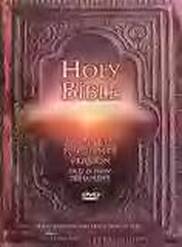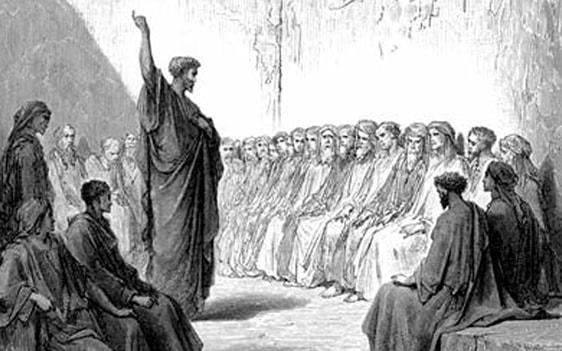Acts 17:1-15
Lesson 260
Read both the "King James Bible" and the "New Living Translation."
In this lesson:
Paul and Silas in Thessalonica and Berea.
How to discern God's truth (17:11-12).
Paul preaching in Thessalonica.
By French artist Gustave Dore (1832-1883).
By French artist Gustave Dore (1832-1883).
Where were -
Amphipolis -
Amphipolis was a Greek city and a Roman military base. The name Amphipolis means "a city surrounded" in Greek. The city was so named because the Strymon River flowed around Amphipolis on three sides. Paul and Silas walked thirty-three miles (a day and a half journey) to Amphipolis after fleeing Philippi. They trekked the Egnatian Way, a five hundred-mile-long highway that carried travelers and trade goods from Rome to the Orient. Amphipolis is now in ruins. The small village of Neochori, with a population of less than 500, is nearby.
Apollonia -
A city in Macedonia on the Egnatian Way. Apollonia was south of Lake Balbe, twenty-seven miles west of Amphipolis, and a sixty-mile walk from Philippi. It was named after the Greek sun god Apollo.
Thessalonica -
A port city of over 200,000 people that lay south of Lake Balbe at the head of the Thermaic Gulf in Macedonia thirty-five miles west of Apollonia and a ninety-five-mile walk from Philippi. Named after Alexander the Great's sister, Thessalonica was the second largest commercial city (after Corinth) in Macedonia, one of the wealthiest and the capital of the province. Because the Thessalonians had been helpful in one of Rome's wars, the city was given great political power and allowed to rule itself via their seven democratically elected politarch's (city rulers) and a senate (Demas). Thessalonica sat on the Roman-built highway, the Egnatia way, that ran from Rome to the Orient, and it had an excellent port on the Aegean Sea. The city took advantage of these two assets and made itself a bustling trade center. Paul founded the church at Thessalonica on his second missionary journey in AD 49-50 (Acts 17:1-4). Soon after establishing the church, Paul was forced to flee the persecution and riots organized against him (Acts 17:5-10). He traveled forty-five miles southwest to Berea and began preaching again. When his enemies in Thessalonica learned where he was, they had him run out of Berea, too (Acts 17:13-14). In AD 51, while in Corinth on his second missionary journey, Paul wrote 1 Thessalonians. Several months later, in AD 52, he penned 2 Thessalonians, making them two of the earliest writings in the New Testament. During World War Two, the entire Jewish population of Thessalonica was sent to the death camps in Nazi occupied-Poland. Thessalonica still exists today and is called Salonika.
Beroea -
Another Macedonian (Greek) city also called Berea. The city is located near Mount Bermius, forty-five miles southwest of Thessalonica. Beroea was a major city with a large Jewish population. Today, Beroea is called Veria and has a population of 70,000.
Amphipolis -
Amphipolis was a Greek city and a Roman military base. The name Amphipolis means "a city surrounded" in Greek. The city was so named because the Strymon River flowed around Amphipolis on three sides. Paul and Silas walked thirty-three miles (a day and a half journey) to Amphipolis after fleeing Philippi. They trekked the Egnatian Way, a five hundred-mile-long highway that carried travelers and trade goods from Rome to the Orient. Amphipolis is now in ruins. The small village of Neochori, with a population of less than 500, is nearby.
Apollonia -
A city in Macedonia on the Egnatian Way. Apollonia was south of Lake Balbe, twenty-seven miles west of Amphipolis, and a sixty-mile walk from Philippi. It was named after the Greek sun god Apollo.
Thessalonica -
A port city of over 200,000 people that lay south of Lake Balbe at the head of the Thermaic Gulf in Macedonia thirty-five miles west of Apollonia and a ninety-five-mile walk from Philippi. Named after Alexander the Great's sister, Thessalonica was the second largest commercial city (after Corinth) in Macedonia, one of the wealthiest and the capital of the province. Because the Thessalonians had been helpful in one of Rome's wars, the city was given great political power and allowed to rule itself via their seven democratically elected politarch's (city rulers) and a senate (Demas). Thessalonica sat on the Roman-built highway, the Egnatia way, that ran from Rome to the Orient, and it had an excellent port on the Aegean Sea. The city took advantage of these two assets and made itself a bustling trade center. Paul founded the church at Thessalonica on his second missionary journey in AD 49-50 (Acts 17:1-4). Soon after establishing the church, Paul was forced to flee the persecution and riots organized against him (Acts 17:5-10). He traveled forty-five miles southwest to Berea and began preaching again. When his enemies in Thessalonica learned where he was, they had him run out of Berea, too (Acts 17:13-14). In AD 51, while in Corinth on his second missionary journey, Paul wrote 1 Thessalonians. Several months later, in AD 52, he penned 2 Thessalonians, making them two of the earliest writings in the New Testament. During World War Two, the entire Jewish population of Thessalonica was sent to the death camps in Nazi occupied-Poland. Thessalonica still exists today and is called Salonika.
Beroea -
Another Macedonian (Greek) city also called Berea. The city is located near Mount Bermius, forty-five miles southwest of Thessalonica. Beroea was a major city with a large Jewish population. Today, Beroea is called Veria and has a population of 70,000.
Study Tip:
The Bible is complex, so it helps to study more than one translation. As you read each lesson, scroll back and forth between the "King James Version" and the "New Living Translation" below.
Also, check the margin notes in blue and click on the links.
The Bible is complex, so it helps to study more than one translation. As you read each lesson, scroll back and forth between the "King James Version" and the "New Living Translation" below.
Also, check the margin notes in blue and click on the links.




